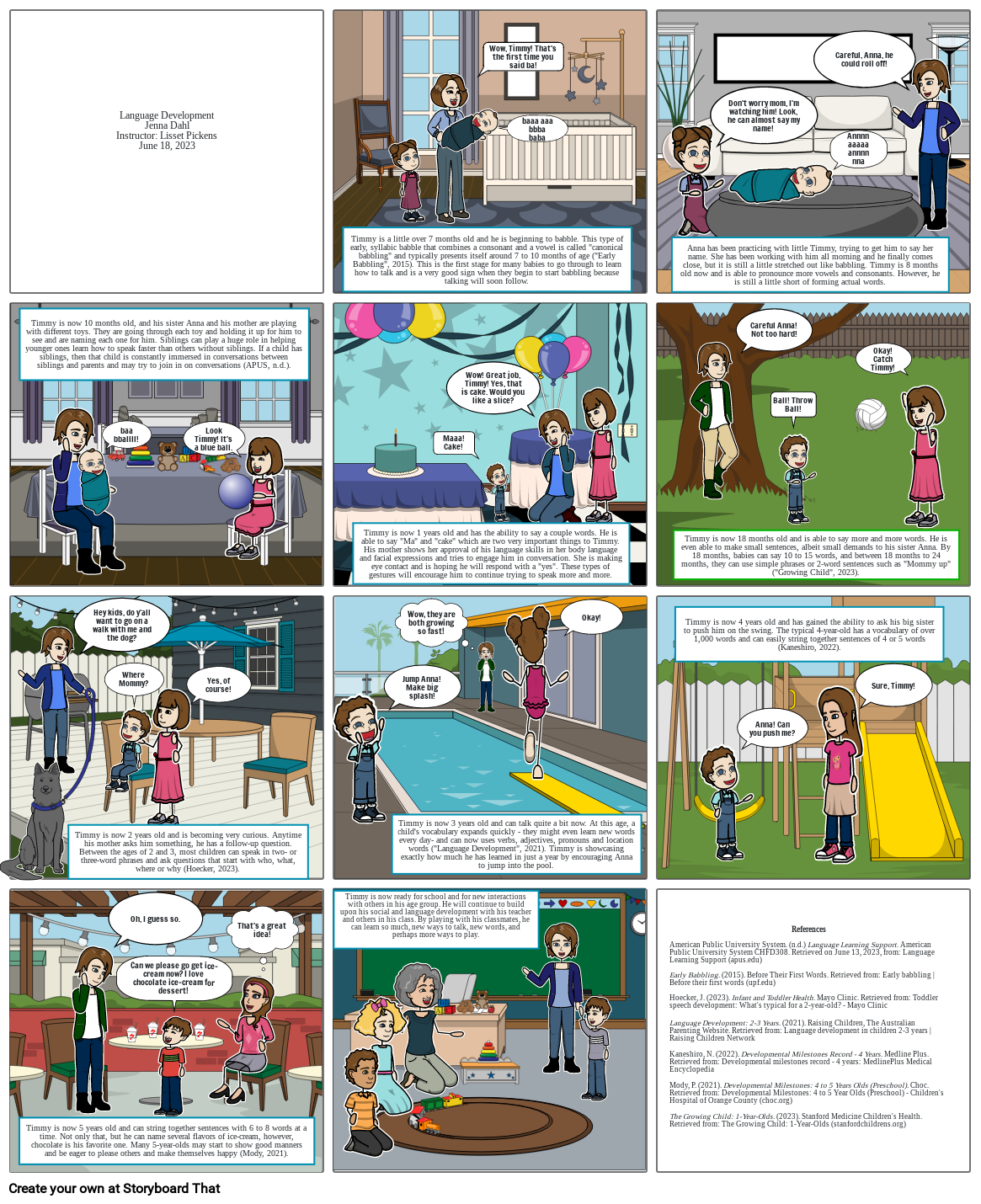Language Development-CHFD308-Jenna Dahl

Storyboard Text
- Language DevelopmentJenna DahlInstructor: Lisset PickensJune 18, 2023
- Timmy is a little over 7 months old and he is beginning to babble. This type of early, syllabic babble that combines a consonant and a vowel is called "canonical babbling" and typically presents itself around 7 to 10 months of age ("Early Babbling", 2015). This is the first stage for many babies to go through to learn how to talk and is a very good sign when they begin to start babbling because talking will soon follow.
- Wow, Timmy! That's the first time you said ba!
- baaa aaa bbbababa
- Anna has been practicing with little Timmy, trying to get him to say her name. She has been working with him all morning and he finally comes close, but it is still a little stretched out like babbling. Timmy is 8 months old now and is able to pronounce more vowels and consonants. However, he is still a little short of forming actual words.
- Don't worry mom, I'm watching him! Look, he can almost say my name!
- Careful, Anna, he could roll off!
- Annnnaaaaaannnnnna
- Timmy is now 10 months old, and his sister Anna and his mother are playing with different toys. They are going through each toy and holding it up for him to see and are naming each one for him. Siblings can play a huge role in helping younger ones learn how to speak faster than others without siblings. If a child has siblings, then that child is constantly immersed in conversations between siblings and parents and may try to join in on conversations (APUS, n.d.).
- baabballll!
- Look Timmy! It's a blue ball.
- Timmy is now 1 years old and has the ability to say a couple words. He is able to say "Ma" and "cake" which are two very important things to Timmy. His mother shows her approval of his language skills in her body language and facial expressions and tries to engage him in conversation. She is making eye contact and is hoping he will respond with a "yes". These types of gestures will encourage him to continue trying to speak more and more.
- Maaa! Cake!
- Wow! Great job, Timmy! Yes, that is cake. Would you like a slice?
- Timmy is now 18 months old and is able to say more and more words. He is even able to make small sentences, albeit small demands to his sister Anna. By 18 months, babies can say 10 to 15 words, and between 18 months to 24 months, they can use simple phrases or 2-word sentences such as "Mommy up" ("Growing Child", 2023).
- Careful Anna! Not too hard!
- Ball! Throw Ball!
- Okay! Catch Timmy!
- Timmy is now 2 years old and is becoming very curious. Anytime his mother asks him something, he has a follow-up question. Between the ages of 2 and 3, most children can speak in two- or three-word phrases and ask questions that start with who, what, where or why (Hoecker, 2023).
- Hey kids, do y'all want to go on a walk with me and the dog?
- Where Mommy?
- Yes, of course!
- Jump Anna! Make big splash!
- Timmy is now 3 years old and can talk quite a bit now. At this age, a child's vocabulary expands quickly - they might even learn new words every day- and can now uses verbs, adjectives, pronouns and location words ("Language Development", 2021). Timmy is showcasing exactly how much he has learned in just a year by encouraging Anna to jump into the pool.
- Wow, they are both growing so fast!
- Okay!
- Timmy is now 4 years old and has gained the ability to ask his big sister to push him on the swing. The typical 4-year-old has a vocabulary of over 1,000 words and can easily string together sentences of 4 or 5 words (Kaneshiro, 2022).
- Anna! Can you push me?
- Sure, Timmy!
- Timmy is now 5 years old and can string together sentences with 6 to 8 words at a time. Not only that, but he can name several flavors of ice-cream, however, chocolate is his favorite one. Many 5-year-olds may start to show good manners and be eager to please others and make themselves happy (Mody, 2021).
- Oh, I guess so.
- Can we please go get ice-cream now? I love chocolate ice-cream for dessert!
- That's a great idea!
- Timmy is now ready for school and for new interactions with others in his age group. He will continue to build upon his social and language development with his teacher and others in his class. By playing with his classmates, he can learn so much, new ways to talk, new words, and perhaps more ways to play.
- ReferencesAmerican Public University System. (n.d.) Language Learning Support. American Public University System CHFD308. Retrieved on June 13, 2023, from: Language Learning Support (apus.edu)Early Babbling. (2015). Before Their First Words. Retrieved from: Early babbling | Before their first words (upf.edu)Hoecker, J. (2023). Infant and Toddler Health. Mayo Clinic. Retrieved from: Toddler speech development: What's typical for a 2-year-old? - Mayo ClinicLanguage Development: 2-3 Years. (2021). Raising Children, The Australian Parenting Website. Retrieved from: Language development in children 2-3 years | Raising Children NetworkKaneshiro, N. (2022). Developmental Milestones Record - 4 Years. Medline Plus. Retrieved from: Developmental milestones record - 4 years: MedlinePlus Medical Encyclopedia Mody, P. (2021). Developmental Milestones: 4 to 5 Years Olds (Preschool). Choc. Retrieved from: Developmental Milestones: 4 to 5 Year Olds (Preschool) - Children's Hospital of Orange County (choc.org)The Growing Child: 1-Year-Olds. (2023). Stanford Medicine Children's Health. Retrieved from: The Growing Child: 1-Year-Olds (stanfordchildrens.org)
Over 30 Million Storyboards Created

